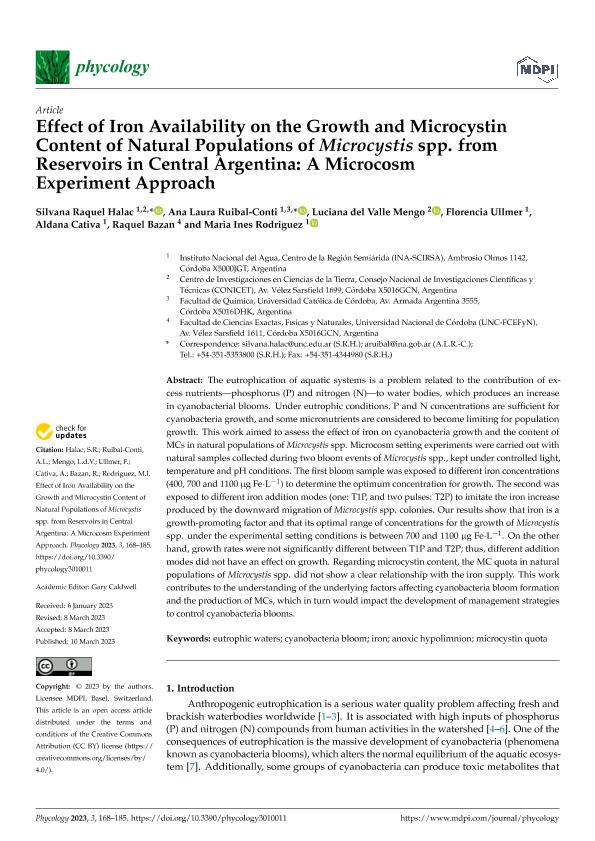Mostrar el registro sencillo del ítem
dc.contributor.author
Halac, Silvana Raquel

dc.contributor.author
Ruibal Conti, Ana Laura

dc.contributor.author
Mengo, Luciana del Valle

dc.contributor.author
Ullmer, Florencia

dc.contributor.author
Cativa, Aldana Berenice

dc.contributor.author
Bazán, Raquel del Valle

dc.contributor.author
Rodriguez, Maria Ines
dc.date.available
2024-02-08T13:01:53Z
dc.date.issued
2023-03
dc.identifier.citation
Halac, Silvana Raquel; Ruibal Conti, Ana Laura; Mengo, Luciana del Valle; Ullmer, Florencia; Cativa, Aldana Berenice; et al.; Effect of Iron Availability on the Growth and Microcystin Content of Natural Populations of Microcystis spp. from Reservoirs in Central Argentina: A Microcosm Experiment Approach; MDPI; Phycology; 2023; 3; 3-2023; 168-185
dc.identifier.issn
2673-9410
dc.identifier.uri
http://hdl.handle.net/11336/226370
dc.description.abstract
The eutrophication of aquatic systems is a problem related to the contribution of excess nutrients?phosphorus (P) and nitrogen (N)?to water bodies, which produces an increase in cyanobacterial blooms. Under eutrophic conditions, P and N concentrations are sufficient for cyanobacteria growth, and some micronutrients are considered to become limiting for population growth. This work aimed to assess the effect of iron on cyanobacteria growth and the content of MCs in natural populations of Microcystis spp. Microcosm setting experiments were carried out with natural samples collected during two bloom events of Microcystis spp., kept under controlled light, temperature and pH conditions. The first bloom sample was exposed to different iron concentrations (400, 700 and 1100 μg Fe·L−1) to determine the optimum concentration for growth. The second was exposed to different iron addition modes (one: T1P, and two pulses: T2P) to imitate the iron increase produced by the downward migration of Microcystis spp. colonies. Our results show that iron is a growth-promoting factor and that its optimal range of concentrations for the growth of Microcystis spp. under the experimental setting conditions is between 700 and 1100 μg Fe·L−1. On the other hand, growth rates were not significantly different between T1P and T2P; thus, different addition modes did not have an effect on growth. Regarding microcystin content, the MC quota in natural populations of Microcystis spp. did not show a clear relationship with the iron supply. This work contributes to the understanding of the underlying factors affecting cyanobacteria bloom formation and the production of MCs, which in turn would impact the development of management strategiesto control cyanobacteria blooms.
dc.format
application/pdf
dc.language.iso
eng
dc.publisher
MDPI
dc.rights
info:eu-repo/semantics/openAccess
dc.rights.uri
https://creativecommons.org/licenses/by/2.5/ar/
dc.subject
EUTROPHIC WATERS
dc.subject
CYANOBACTERIA BLOOM
dc.subject
IRON
dc.subject
ANOXIC HYPOLIMNION
dc.subject
MICROCYSTIN QUOTA
dc.subject.classification
Biología Celular, Microbiología

dc.subject.classification
Ciencias Biológicas

dc.subject.classification
CIENCIAS NATURALES Y EXACTAS

dc.title
Effect of Iron Availability on the Growth and Microcystin Content of Natural Populations of Microcystis spp. from Reservoirs in Central Argentina: A Microcosm Experiment Approach
dc.type
info:eu-repo/semantics/article
dc.type
info:ar-repo/semantics/artículo
dc.type
info:eu-repo/semantics/publishedVersion
dc.date.updated
2024-02-06T13:43:14Z
dc.journal.volume
2023
dc.journal.number
3
dc.journal.pagination
168-185
dc.journal.pais
Suiza

dc.journal.ciudad
Basilea
dc.description.fil
Fil: Halac, Silvana Raquel. Consejo Nacional de Investigaciones Científicas y Técnicas. Centro Científico Tecnológico Conicet - Córdoba. Centro de Investigaciones en Ciencias de la Tierra. Universidad Nacional de Córdoba. Facultad de Ciencias Exactas Físicas y Naturales. Centro de Investigaciones en Ciencias de la Tierra; Argentina. Secretaria de Ambiente y Desarrollo Sustentable de la Nación. Instituto Nacional del Agua y del Ambiente (Córdoba); Argentina
dc.description.fil
Fil: Ruibal Conti, Ana Laura. Secretaria de Ambiente y Desarrollo Sustentable de la Nación. Instituto Nacional del Agua y del Ambiente (Córdoba); Argentina
dc.description.fil
Fil: Mengo, Luciana del Valle. Consejo Nacional de Investigaciones Científicas y Técnicas. Centro Científico Tecnológico Conicet - Córdoba. Centro de Investigaciones en Ciencias de la Tierra. Universidad Nacional de Córdoba. Facultad de Ciencias Exactas Físicas y Naturales. Centro de Investigaciones en Ciencias de la Tierra; Argentina
dc.description.fil
Fil: Ullmer, Florencia. Secretaria de Ambiente y Desarrollo Sustentable de la Nación. Instituto Nacional del Agua y del Ambiente (Córdoba); Argentina
dc.description.fil
Fil: Cativa, Aldana Berenice. Secretaria de Ambiente y Desarrollo Sustentable de la Nación. Instituto Nacional del Agua y del Ambiente (Córdoba); Argentina
dc.description.fil
Fil: Bazán, Raquel del Valle. Universidad Nacional de Córdoba. Facultad de Ciencias Exactas, Físicas y Naturales; Argentina
dc.description.fil
Fil: Rodriguez, Maria Ines. Secretaria de Ambiente y Desarrollo Sustentable de la Nación. Instituto Nacional del Agua y del Ambiente (Córdoba); Argentina
dc.journal.title
Phycology
dc.relation.alternativeid
info:eu-repo/semantics/altIdentifier/url/https://www.mdpi.com/2673-9410/3/1/11
dc.relation.alternativeid
info:eu-repo/semantics/altIdentifier/doi/http://dx.doi.org/10.3390/phycology3010011
Archivos asociados
